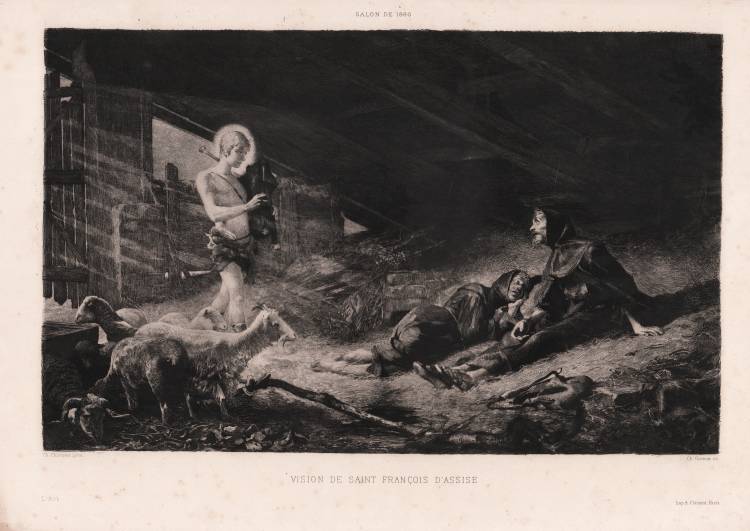



| Riferimento: | S46011 |
| Autore | Andrè Giroux |
| Anno: | 1886 |
| Misure: | 410 x 295 mm |


| Riferimento: | S46011 |
| Autore | Andrè Giroux |
| Anno: | 1886 |
| Misure: | 410 x 295 mm |
L'opera mostra San Francesco che, in un'umile stalla, ha una visione di Gesù Bambino. Il santo è raffigurato con un'aureola, mentre suona un violino in un'atmosfera di profonda devozione. Accanto a lui ci sono delle pecore, simbolo della sua connessione con la natura e gli animali. Sul lato opposto, una famiglia di poveri osserva la scena con stupore e speranza, riflettendo l'attenzione di San Francesco verso i bisognosi.
Pubblicata in “L'Art”, 1886.
Da un dipinto di Charles-François-Prosper Chartran.
Acquaforte, 186 circa, firmata in basso dove sono riportati anche i dettagli di produzione.
Buona impressione su carta vergata coeva, con margini, ottimo stato di conservazione.
Andrè Giroux Parigi 1801 - 1879
|
André Giroux was born in Paris in 1801. By the time the Paris-based painter André Giroux won the Prix de Rome for historical landscape painting in 1825, he had already been exhibiting his composed, classical landscapes at the Salon for several years. In Rome, where he remained until 1830, he made friends with the young and innovative landscape painters living in the city, including Corot, Edouard Bertin and Léon Fleury. He frequently painted and sketched out of doors with them. Giroux sent many of his oil sketches back to Paris, where one such series of Italian studies won him a first-class medal at the Salon of 1831.
|
Andrè Giroux Parigi 1801 - 1879
|
André Giroux was born in Paris in 1801. By the time the Paris-based painter André Giroux won the Prix de Rome for historical landscape painting in 1825, he had already been exhibiting his composed, classical landscapes at the Salon for several years. In Rome, where he remained until 1830, he made friends with the young and innovative landscape painters living in the city, including Corot, Edouard Bertin and Léon Fleury. He frequently painted and sketched out of doors with them. Giroux sent many of his oil sketches back to Paris, where one such series of Italian studies won him a first-class medal at the Salon of 1831.
|